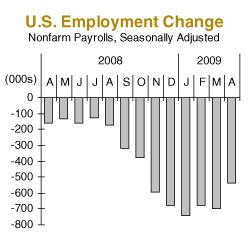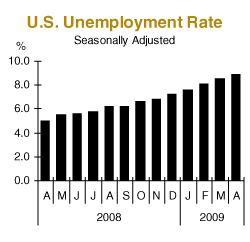|
May 13, 2009
Ugly…Less Ugly
Written by Jeff Thredgold, CSP, President, Thredgold Economic Associates
 Make no mistake about it… Make no mistake about it…
…the loss of 539,000 net jobs in April was terrible
However, when compared to even greater job losses in prior months, April’s decline—the smallest since last October—was one more minuscule sign of impending life in the American economy.
The 539,000 decline in U.S. employment in April was slightly less than economists had projected. It was, however, the seventh worst monthly job loss of the past 50 years. Five of the six worst months for U.S. job losses were in recent months.
On another dismal note, job losses of the two prior months were revised higher (meaning worse) by 66,000 jobs. An estimated 72% of private industry sectors reported job losses in April, a small improvement versus the 80% of sectors that cut jobs in March (CNNMoney.com).
Four Million New Jobs Monthly!
What??
Monthly employment reports provide only the net change in total employment in an enormous economy which employs more than 140 million people. In fact, the U.S. economy adds more than four million new jobs monthly, with the 4.4 million new hires in February the latest data available (The Wall Street Journal). The obvious problem is the loss of even more jobs in recent months.
An amazing amount of job “churning” takes place in the economy, with roughly 50 million new jobs added during the past year, unfortunately offset by the elimination of around 55 million jobs. Thousands of American and global employers are cutting jobs in select departments and divisions, while adding to payrolls in other departments and divisions. Thousands of small businesses fail, while similar numbers open their doors.
The challenge is matching the skills needed in an ever-changing economy with the skills available. Training and retraining are now the norm in the American economy.
|
|
In addition, the U.S. unemployment rate jumped to 8.9% in April versus 8.5% in March. The gain matched economists’ consensus forecast. While the rate was at a 25-year high, one arguably positive development accounted for the rise (see below).
Worst on Record
Total American employment is down 5.7 million jobs since this lengthy and painful recession officially began in December 2007. The loss of 3.9 million jobs during the past six months is the worst six-month performance on record.
Moreover, most forecasters expect the loss of another two million jobs or so over the balance of the year. While the majority of forecasters still expect the U.S. economy to return to minimal growth before the end of 2009, most see monthly job losses continuing until year’s end.
Where the Pain Was
No surprise here…the nation’s goods-production sector got hammered again, with the loss of another 270,000 jobs. The nation’s manufacturing sector lost another 149,000 jobs, while construction employment fell by another 110,000 positions.
The larger service-providing sector recorded a net decline of 269,000 jobs in April, led by the loss of another 122,000 jobs in professional & business services and a net decline of 44,000 jobs in leisure & hospitality. The retail trade sector saw net payrolls fall by another 47,000 positions.
Education and health services employment rose by 15,000 net jobs, while government employment jumped by 72,000 jobs, the largest gain in eight years. Such employment will continue to rise as the U.S. government hires an estimated 1.4 million people in coming months to conduct the 2010 census.
 8.9% 8.9%
While the jobless rate jumped sharply to 8.9% as expected, the reason it did so contained some optimism. As we have noted many times in the past, the monthly measure of net job creation (or loss) and the monthly measure of unemployment come from different surveys.
The loss of a net 539,000 jobs in April came from the establishment survey of roughly 300,000 or so businesses. The unemployment rate derives from a smaller survey of around 60,000 households.
Note that the household survey recorded a net gain of 120,000 jobs during April. However, the estimated labor force rose by 683,000 workers. The sharp rise in the number of people seeking jobs reflects different things.
In part, it reflects the fact that more people are seeking work in order to make ends meet, especially if another family member has lost their job. The rise can also, however, reflect the fact that people are more optimistic about finding a job now than a few months ago, and have re-entered the labor force.
The latest data suggests just how painful the recession has been for too many thousands and thousands and thousands of people. An estimated 27% of the 13.7 million people now officially counted as unemployed have been out of work for more than six months, the highest percentage of long-term unemployed among the jobless population since such data was collected beginning in 1948. Better news saw a slight decline in the number of people who were unemployed for less than 15 weeks.
As one might expect, weakness in employment led to extremely modest growth in wages. The average hourly wage rose only one cent to $18.51 hourly, the smallest monthly increase in four years. However, the 3.2% rise in the average hourly wage during the past year compares favorably to the actual 0.4% decline in the Consumer Price Index during the most recent 12-month period.
By Gender…By Race
The unemployment rate for adult men jumped to 9.4% in April, versus 8.8% in March. The rate for adult women rose slightly to 7.1% from the prior month’s 7.0% rate.
The jobless rate for Whites rose to 8.0% from March’s 7.9% rate. The rate for Blacks or African Americans rose sharply to 15.0% from 13.3% the prior month. The jobless rate for those of Hispanic or Latino ethnicity actually declined slightly from 11.4% to 11.3%. The unemployment rate for teenagers dipped slightly to 21.5% from 21.7% in March.
Less Painful?
The past six months—indeed the past 16 months—have been painful for American workers. More pain is in store. However, the expected return to modestly positive U.S. economic growth in coming quarters should lead to fewer job losses and greater opportunities for American workers and their families…
…keep your fingers crossed
• Email this article to a friend
• Learn about econAmerica, Jeff’s latest book
|
|
Subscribe to the Tea Leaf
Like what you just read? Have Jeff Thredgold’s Tea Leaf emailed to you free each week. Subscribe today.
|
|
|

“Tea”ser
“I am enclosing two tickets to the first night of my new play;
bring a friend…if you have one.”
“Cannot possibly attend first night, will attend second…if there is one.”

“Tea”stimonial
“We have received nothing but raves from our members who attended your session. Your ability to capture the attention of the audience was remarkable. The presentation was informative, well paced, and most importantly, fun!”
• More testimonials
Invite Jeff Thredgold to speak at your next conference, meeting, or client function
If you like the Tea Leaf, you’ll love Jeff Thredgold’s live presentations. Jeff takes your audience on a timely, engaging, and entertaining tour of the U.S. economy and financial markets. Debunking some of today’s most common economic myths, he offers a clear picture of how the American economy is really performing and what that means for the future of your finances.
• ***Watch Jeff Thredgold’s new streaming demo video.***
• Download more information that you can e-mail to other decision makers.
• See Jeff Thredgold’s speaking calendar.
• Tell us about your event using our online form and we will contact you. Or, is there an individual in your organization you would like us to contact?
• Give us a call at 1-888-THREDGOLD (847-3346) to ask about Jeff’s availability and pricing for your event, or for any other information.
|
